
Agfa’s enlarger lenses never achieved the global awareness of other German brands, or other products in its stable. PhotoCornucopia’s Big List only listed two; in 1983 the ‘Darkroom Magazine’ overview overlooked them; forum chatter goes quiet when you ask. In fact, you can read widely online and never learn Agfa ever made them. Vade Mecum – which can usually be relied upon to say something – on this point says nothing: a Color Solagon DI 70/4.5 is mentioned but not identified as an enlarger lens. And yet Agfa had a wide portfolio: Solinar-S, (Color-)Magnolar, Color-Magnolar II, Magnolar, Colostar-N, Colostar-U, and Color-Solagon in versions DI and DII. Delta currently lists more than forty Agfa-branded enlarger lenses – plus process and industrial lenses – with a low degree of confidence that even this catalogue is complete.
Agfa Varioscop (commonly misspelt ‘Varioscope’) enlargers were sold from the late 1950s until 1974 and were considerably more popular on mainland Europe than in the US or UK. In 1960, the newly-released Varioscop 35/44 was fitted as standard with a Color-Solagon DII-series 60/4.5 but in subsequent years was more commonly packaged with some species of Magnolar. The larger, Italian-made Varioscop 60 was sold alongside the 35/44 in most markets throughout the 1960s and had an excellent reputation. Agfa had close ties with Steinheil in the 1940s and 1950s, and a similar relationship with Durst in the 1970s and 1980s: the Agfa C66 Colormat enlarger was a modified version of the Durst 605.

Unlike brands that seek to appeal to all market segments, Agfa only sold good lenses. Some were very good. It could be argued that Agfa’s (wartime interrupted) Golden Age was 1940-1960, when their camera bodies and taking lenses were world class. But Agfa’s reputation for optical excellence and innovation didn’t rest solely on these deservedly popular products: Agfa’s most impressive mid-century work happened out of the limelight: in their high-end enlarger and industrial lenses, and those made for special applications like the Agfa Recording Camera and the Repromaster range.
However, even during the company’s heyday – in common with many well-known brands (AICO, Beseler, Cambridge, Durst, etc) – Agfa enlarging lenses were rarely made by Agfa: indeed, it is rumoured that the Color-Solagon DI and DII series were the only Agfa models designed and manufactured in-house. Later Magnolar models were jointly marketed by Durst as ‘Neonon’ and were made in Japan – likely by Pentax. The Solinar-S, Color-Magnolar I and II, and Colostar-U/-N models were made in Germany – some perhaps by Staeble (who almost certainly made the Repromasters*). Others were evidently made by, or in collaboration with, Steinheil, given the similarities between Steinheil’s own enlarger lenses and certain Agfa designs.

Adding to the nominal and physical similarities, the trade connection between Steinheil and Agfa is supported by the fact Agfa Varioscop enlargers are often seen – and likely sold – fitted with Steinheil lenses. Although less widely know today, Steinheil München, founded by the titular Carl August von Steinheil in 1855, was a distinguished maker of optical instruments for well over a century. For more on that, please see here >
According to wikiwand.com: “Steinheil supplied various manufacturers and quickly developed an extensive range in this area. From 1950 the Agfa company in Munich was supplied with Steinheil Culminars for their Varioscop enlarger. Some were sold under the Agfa Magnolar name.“

The retaining ring for one of the Agfa standard threads fits exactly on
the Steinheil Culminar 10.5 cm lens.
Note the similarity between these images captured by a Canon EOS R5 using the Steinheil Culminar VL 10.5cm and Agfa Color-Magnolar 105mm – both nominally f4.5 maximum aperture.
The Steinheil Culminar and the Agfa Color-Magnolar are almost on par, particularly when you factor in the actual difference between their (nominal) f4.5 maximum apertures. Because Agfa’s Heliar-based design seems to open up to something closer to f4, while the Steinheil lens shows better correction for CA and is therefore the preferred choice of the two.
When we compare the Steinheil 10.5cm with the Mark II Color-Magnolar, it’s a different story. Here the Agfa is noticeably sharper. While it retains some of the CA issues of its predecessor, overall it’s the best and most desirable of this 105mm trio – at least in terms of its macro performance.
Agfa Solinar S
The Solinar name first appeared to four-element Agfa lenses in the early 1940s – notably in Prontor shutters on Isolar and Isolette folding cameras – and by 1952 was the subject of a unique patent by Agfa. Among enlarger lenses we find a Solinar S 60/4.5 and the Solinar S 105/4.5 – both four-element ‘reverse’ Tessar designs distinguished by angled fascia rings in black noses with silver ‘Steinheil-style’ bodies: large knurled brass aperture rings with triangular markers. Agfa’s spin on the evergreen Tessar was shared with Steinheil’s Culminar, Isco’s Westanar, the Meyer Primotar and a handful of Voigtlander designs of the period – all arranged with the cemented doublet at the front, with separated elements behind.
To dismantle these, and the Magnolars, for cleaning and repair, the nose is rotated out of the lower half, against the stop screw that actuates the diaphragm. If torque is applied to the wrong part of the housing it’s possible to damage the aperture selection ring: quite a few Solinars, Magnolars, and Color-Solagons we’ve seen have misaligned, over-running, or (at worst) free-spinning rings. Apart from that issue, the brass and aluminium cases are well engineered.
Impressions and Sample images Agfa Solinar S 60 mm

The angled ring with the inscription on the front is an easy way to distinguish the Solinar S lenses from the newer Color-Magnolars.
Agfa Magnolar [V1 and V2]
Between the Tessar Solinars and the Heliar Color-Magnolars sits the Magnolar range, consisting of just two focal lengths (60mm and 105mm – both f4.5). Version 1 of the Magnolar 60/4.5 is distinguished by mixed-case lettering on the fascia ring and lower serial numbers. These are four-element designs optically identical to the Solinar-S 60/4.5. This petite lens was a widely-fitted entry-level option for Varioscop enlargers. The Magnolar 60/4.5 Version 2 has upper-case lettering on the fascia, higher serial numbers and is a superior five-element lens probably identical to the Color-Magnolar branded 60/4.5.
In testing, even the basic Magnolar 60/4.5 [V1] performs surprisingly well: scoring just over 85% for near-field averaged sharpness at f5.6-f8. This would have been an excellent enlarger optic – on the same level, for instance, as the EL-Nikkor N 105/5.6 – certainly not a make-weight Varioscop kit lens buyers would have been keen to upgrade. The circular ten-blade aperture makes for natural bokeh. Overall rendition is excellent and it’s recommended as a taking lens – but don’t expect to find an adaptor for its outlying 27.4×0.5mm mount.
Agfa Color-Magnolar
These 5/3 (Heliar type) enlarging lenses are a clear step up from the four-element Solinar S/Magnolar [V1] precursors. They appear to have been the standard lenses that Agfa sold with a lot of their Varioscop enlargers and come in the usual focal lengths. However besides the Color-Magnolar 60/4.5 and the Color-Magnolar 105/4.5 an additional Color-Magnolar 75/4.5 has also been seen online, even though it looks completely different and more like a special purpose lens. Agfa was an early provider of bespoke and short-run lenses for medical, forensic and a wide variety of industrial applications.
In an official Agfa advertisement from the 1960s they are described as six-element lenses, but all samples seen and recorded appear to be five-element. Perhaps at one point Agfa intended to market the Color-Solagon lenses under the Color-Magnolar designation.

Magnolar lenses are described as “6linsige Spitzenobjektive” or “6-element high end lenses”

Both lenses have the same 5/3 design, but the 60mm (left) is labeled Magnolar, and the 105mm (right) is labeled Color-Magnolar.
Agfa Color-Magnolar II
The Mark II’s have the same 5/3 construction, but different casings and improved optics – included upgraded coatings. In my quick tests it seems to hold up fine to the non-Apo six-element lenses. All these Agfa enlarging lenses feature solid metal builds and wonderful circular diaphragms (with fifteen-blades for the 105mm and 10 for the 60mm). Just like their predecessors there is a Color-Magnolar II 60/4.5 and a Color-Magnolar II 105/4.5
Sample Images Color-Magnolar II 105 mm

The Color-Magnolar II lenses look very similar to the first iteration, however they are slightly longer and have an improved optical design and coating.





Agfa Color-Solagon
Color-Solagons are among the least documented – and most underrated – enlarging lenses. According to one catalogue, the Color-Solagon name first appeared on a fast lens for the Agfa Silette in 1956. However, that 50/2 lens was an option for the slightly earlier Karat IV. We can thereby date the range to the late 1950s and 1960s. It seems likely that this six-element lens predated (and ‘inspired’) the Color-Solagon enlarger lenses and subsequent Agfaflex 55/2. The Double-Gauss design was the subject of a unique patent by Agfa. However, the taking lenses feature a different 6/4 construction even though they share the name:

The 80/4.5 and 90/4.5 seem to be based on the 60 mm variant as well.

Agfa seems to have used two different 6/4 designs for their enlarging lenses with the 60, 80 and 90 mm DII variants featuring a 6/4 Plasmat design (similar to the Schneider Componon-S) and the Color-Solagon DI 70/4.5 using a more symmetrical version of the basic Solagon (Double-Gauss) design. So far it looks like this was the only lens Agfa ever used it in, while all of the later (Staeble-made) enlarging and repro-lenses appear to be closer to the Plasmat design.
Primes were produced in four focal lengths:
Color-Solagon-D 60/4.5
Color-Solagon DII 60/4.5
Color-Solagon DI 70/4.5
Color-Solagon DII 80/4.5
Color-Solagon DII 90/4.5

Two Agfa Color-Solagon DII 60/4.5 lenses: optically identical, differently packaged.
Roman numerals are used in other Agfa series to distinguish new models, but in this unique case it seems like DII marks a different design from DI, and it may also designate a different application. There is a Color-Solagon-D 60/4.5 as well as Color-Solagon DII 60/4.5. However, the DII 60mm exists in two (different-looking) versions. One was supplied with the Varioscop 35/44 for a period of time (confirmed by catalogues dating from 1960), but the majority were shipped with Color-Magnolar/Colostar lenses.
The (Color) Solagon DII 60/4.5 was standard on the the 3906 version of Agfa’s Registrierkamera (translated ‘Recording-Camera’ or Register Camera) manufactured from 1961-1970, likely by Alex Jacknau of Berlin whose outwardly identical Radar Camera survived the Registrierkamera into the 1970s. Some versions are labeled Bundeswehr and/or featured the Big J Jacknau logo. More commonly the 3900 series are seen with Agfa Color-Telinear 90/3.4 (fitted via the f2 Zwischenring Typ 3923 adaptor), Agfa Color-Solinar 50/2.8, Agfa Color-Ambion 35/4 and Agfa Color-Telinear 130/4.5 but samples have been observed with Schneider Curtagon 35/2.8 and Rodenstock Rotelar 75/4 lenses. Likely the Solagon-equipped Registrierkamera was intended for close range work and the DII version of the 60/4.5 may have been optimised for this application, hence the distinction from the Color-Solagon D 60/4.5.
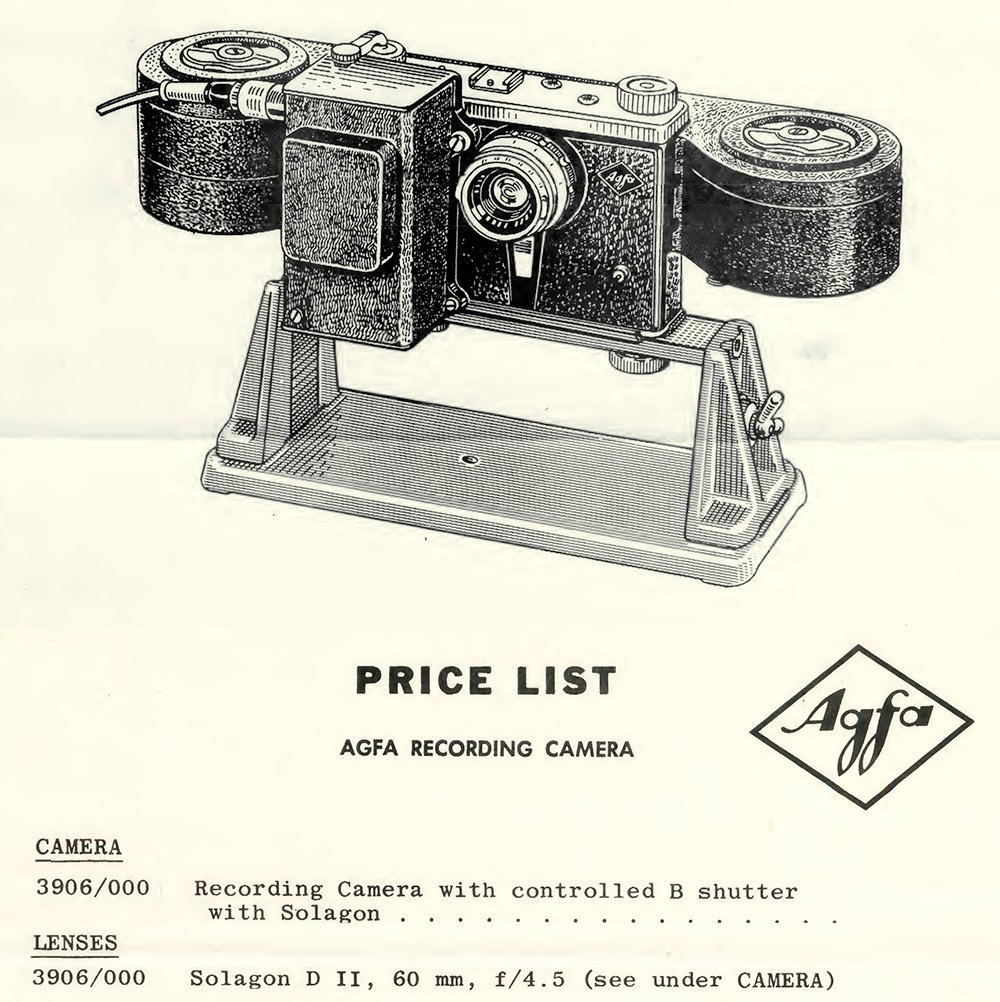
Serial numbers further muddy the water: given B- C- and E-prefixes, we would hope for a chronological/alphabetical sequence, but the DII’s come earlier (alphabetically) than the DI’s. And the DII 90 skips a letter and reverts to five digital all-number serials like the sub-75 mm Colostars. And the Color-Solagon D 60 has an M-prefix.
The Color-Solagon 70mm, 80mm and 90mm were perhaps used in a minilab or a similar device because they come with a retaining ring that wouldn‘t be necessary when used in an Agfa enlarger. The 90 mm has an aperture scale on the rear of the lens but the rest of the range mysteriously leaves the user guessing as to which aperture is selected. Mounts are always 0.5mm fine pitch, with diameters of 27.4 mm, 39 mm and 42 mm.

The 70mm is almost twice the weight of the 80mm, despite having the same nominal maximum aperture. However, the 70mm has an internal baffle that, if removed, would give a maximum aperture closer to f/2, albeit with compromised image quality. While the front external diameter of all three lenses is somewhat similar, the front element of the 70/4.5 version is bigger (31 mm) than the 80/4.5 and 90/4.5 (27 mm) and the rear element is considerably larger (38 mm v 28-29 mm). It’s an optical heavyweight, too: scoring 88% for far distance and 90.1% for near field – sharper than any other Agfa lens, and matching of state-of-the-art lenses like the EL-Nikkor 80/5.6, Fuji EX 75/4.5, Kodak Ektar 75/4.5 and Schneider Apo Componon 90/4.5. Its overall sharpness is a little notch above lenses you might expect it be competitive with: ie, Rodenstock Rodagon 80/4 and Schneider Componon 80/4 – closer, in fact, to the elite-level Apo-Rodagon-N 80/4. For full details, please see the Hall of Fame > and the 70 mm DI listing.
The 80 mm f/4.5 DII is also a very sharp lens, scoring 88.2% for near-field f5.6-f8 average, but dipping quite hard to 85.8% at distance, where the corners suffer relative to its shorter sibling. Again, for full details, see the 70-85 mm Group Review and the 80 mm DII listing.

The Agfa Color-Solagon 70 mm DI, 80 mm DII and 90 mm DII lenses show quite significant differences in weight, size and design.
I‘ve never encountered what I would consider a ‘perfect’ sample of this lens – not even close, actually! Most suffer from coating damage, fungus or separation issues which makes it hard to judge their original quality. Unlike fine wine, lenses do not improve with age. Perhaps susceptibility to such issues lead to the untimely discontinuation of this promising family of lenses.
However, Color-Solagons prove to be wonderful taking lenses, resolving tremendous detail across a wide range of magnifications and they have among the smoothest rendering of any enlarging lens with minimal mechanical vignetting and circular apertures, combined with near-apochromatic colour rendition. Because they are largely unknown they don‘t usually fetch high prices, but they are are likely to require servicing and many samples are already beyond practical repair – which is a pity, because these beautiful, enigmatic lenses are worth preserving at any cost.


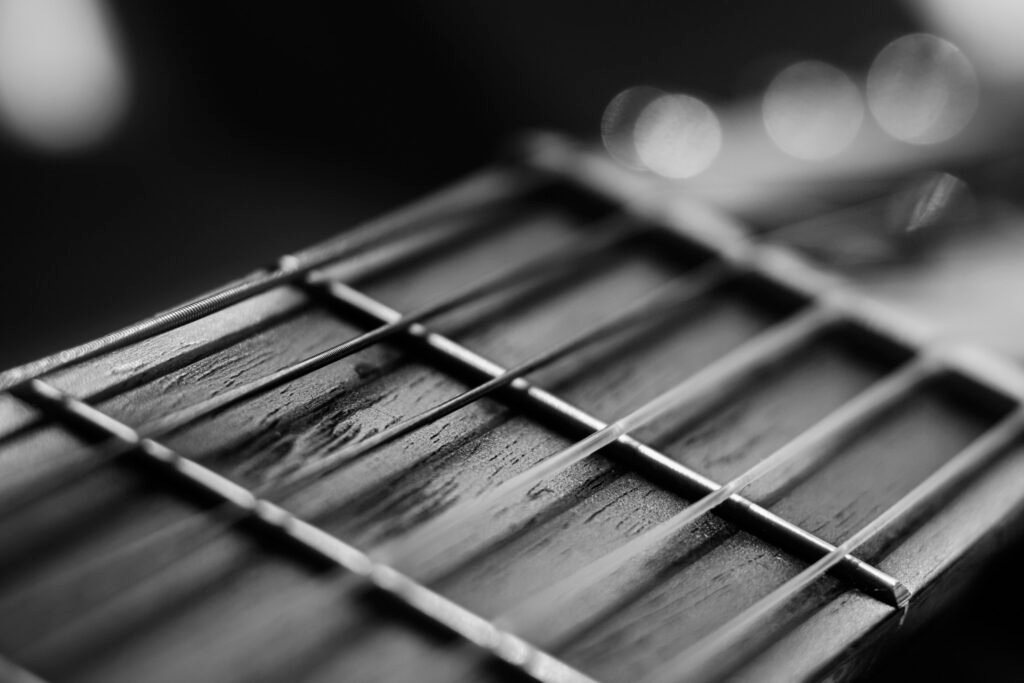

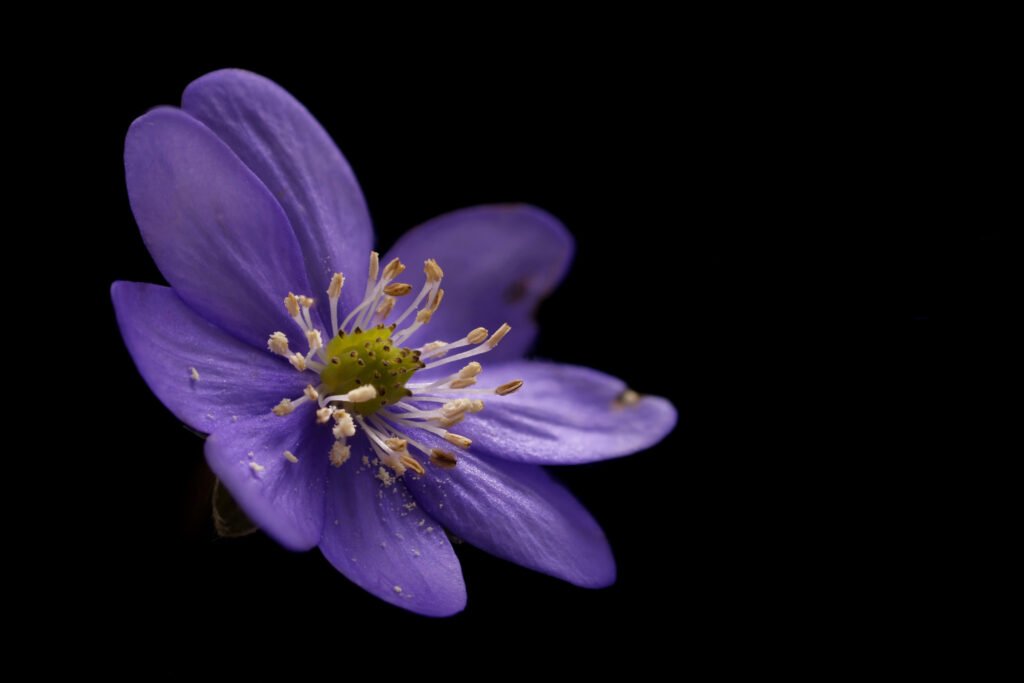


Agfa Colostar Series (N and U)
See ‘Agfa-Gevaert: Industrial Lenses‘ article.
Agfa Magnolar [V3] / Durst Neonon
The later, all-black, Japanese-made Magnolars share only a name with their predecessors. The Magnolar 50/2.8, Magnolar 80/5.6 and Magnolar 105/5.6 were jointly marketed by Durst as ‘Neonon’ and launched early in the second quarter of 1978. The three versions of this lens appear interchangeably marked AGFA MAGNOLAR and Durst Neonon as late as 2000. Engraved ‘Made in Japan’, uncertainty still surrounds the maker. Here’s a round-up of current theories:
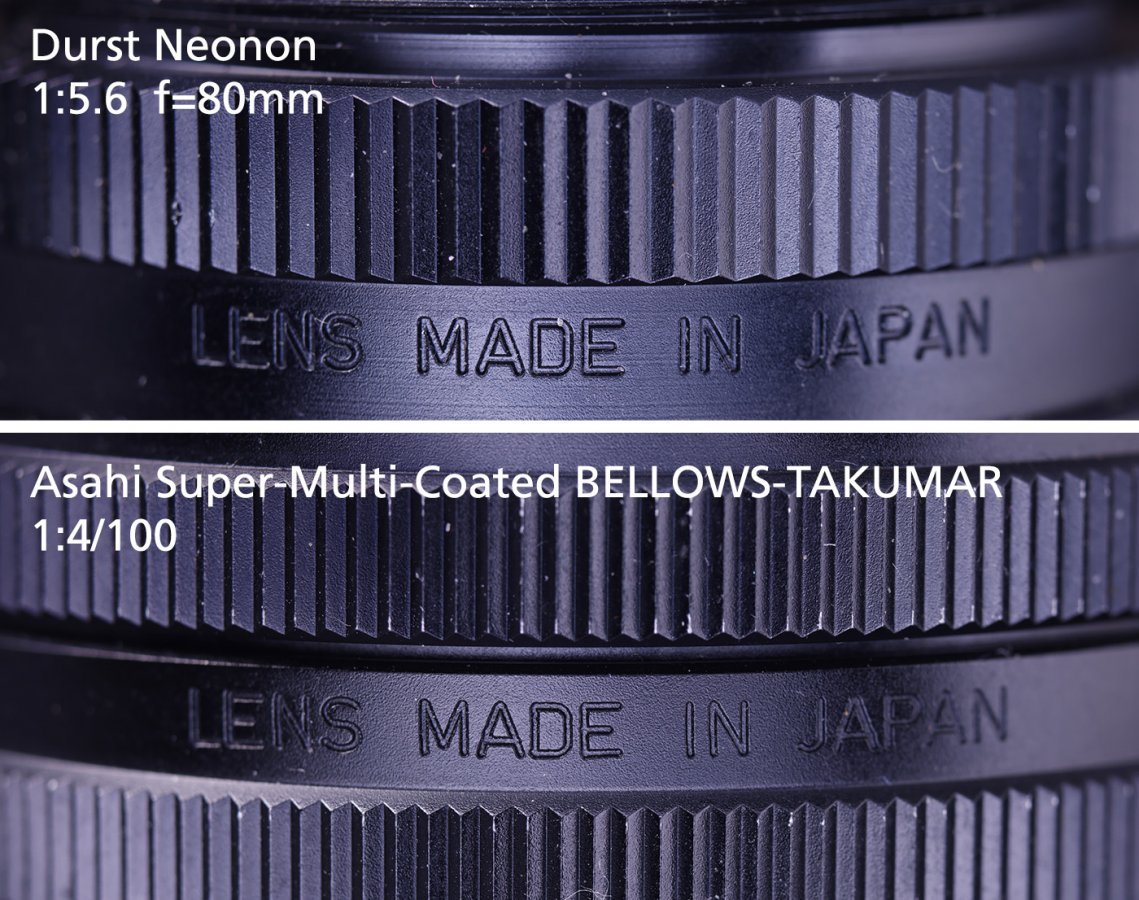
A: It was Pentax. Why? Durst officially refused to name names, but whispers have long leaked out that Neonon/Magnolars were made by Pentax. Circumstantial evidence is quite strong. There are said to be rare and collectable Pentax-EL-branded Neonon/Magnolars in circulation: a Pentax-EL 50/2.8 appears to have been sold in 2003 – as verified by one experienced vendor – but no images survive. Pentax SMC-A lenses of this period certainly have a similar look and feel: with flat black fascia rings, silver rings on the nose and distinctive stippled rubber control rings. As the above picture shows, even the typography and knurling is identical. Furthermore, Asahi Optical Co was the Japanese distributor of Durst enlargers from at least 1978 to at least 1998 – lending credence to claims Pentax made the lenses – but potentially explaining away the appearance of Pentax branding without proving Pentax was the manufacturer. Pentax released a 6-element, 4-group SMC-A 50mm f2.8 Macro lens approximately eighteen months after the launch of the Neonon/Magnolar V1s which is a strong candidate to be a cell transplant from an enlarger lens into a taking helical. Note that the six-digit serial numbers of this lens all begin 5xxxxx and the five-digit serial numbers of the Neonon/Magnolars all begin 5xxxx. Or,
B: It was Minolta. Why? Because they have a 50/2.8 and 80/5.6, and Agfa were rumoured to have had some kind of manufacturing relationship with Minolta in the 1970s and the companies collaborated on the 1996 ActionCam. However, the CEs are optically quite different, and far superior to the Neonons, and they’re not the same as the entry-level E-Rokkors either.
C: It was Fuji. Why? Because they’re Japanese.
D: It was Olympus. Why? See above.
E: It was Hoya/Osawa. Why? Because they’re Japanese, and made many lenses for re-branders.
F: It was Komura. Why? See above.
G: It was Tomioka. Why? See above.
H: It was Cosina. Why? See Minolta, minus the experience with enlarging lenses.
H: It was Nikon. Why? Well . . . Nikon do have lenses at those focal lengths. They’re physically similar, and Nikon retired a very good range of lenses with exactly those specifications within a year of the Neonon’s launch. Speculation that Durst purchased and repackaged pre-N EL-Nikkors is tempting, given that Durst followed the same MO purchasing and repackaging Schneider’s outgoing Componon (V2) design and launching it about the same moment Schneider moved on to Componon-S. But, for the time being, who knows?
What isn’t in dispute is that these are high quality six-element lenses. The 80/5.6 scores a solid Silver 85.3% for near-field f5.6-f8 average sharpness but drops, almost into Bronze territory, to 80.3% for distance. For their intended application, these later lenses are superior in most respects to the Magnolar and Colostar optics, but they don’t approach the level of Agfa’s best, which get Gold awards for sharpness and are better corrected for CA and field curvature.
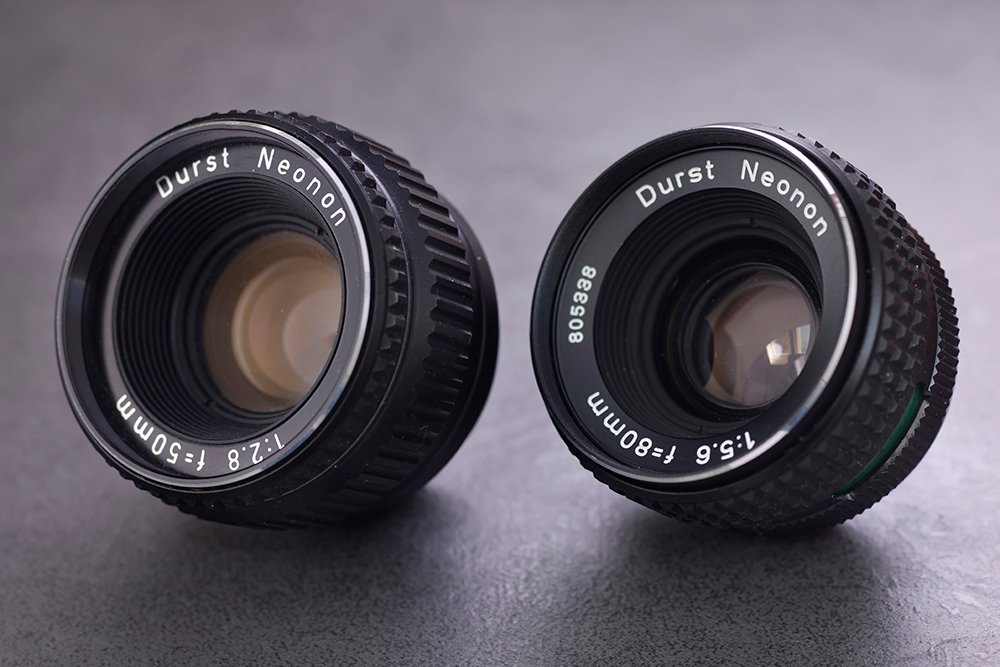
These jointly marketed Japanese lenses are seen branded as Durst Neonon and Agfa Magnolar.
Agfa Enlarging Lens Serial Numbers
See Agfa Introduction page.
Additional chapters in the Agfa-Gevaert story:
Dear Johannes,
thank you for this great review about Agfa enlarger lenses. I must search my AGFA enlarger lenses for further experiments with them. We will stay in contact
Best regards
Bernhard
Thanks a lot! Glad you think so. I’m glad that you’re getting out your Agfa enlarging lenses again as well – always great to see how other people use them.
Pingback:Täglich ein Bild — 15.04.2022 — 105.Tag — Bild #105 — Ich sehe rot! #7 — DND 10 / 2022 – “Close to the ground” #40 – Rot getulptes – Der Amateur Photograph
Great article. Thanks for the love and dedication to expose some light out of these lenses that few know exist.
Thank you very much for the nice feedback! While there are many more interesting but underappreciated lenses we want to cover, Agfa ELs were a great place to start, because they have been among my personal favorites for a while. I hope some of it shows in the sample shots.
Splendid writing, article and, of course, superb photos! If I could find one or two, I would enjoy trying them. I have enjoyed quickly perusing your article, but will return to read again—you don’t plan to remove this article, I hope!
Thanks a lot for your interest and your kind words! I’m really glad you think so. We have no plans to remove the article – I’m sure it will be slightly expanded however as new information arises.
Unfortunately, I find the gray text is unreadable against the black background.
Thanks for your interest and the valuable feedback. You’re correct and we’re working on fixing it.
This article is so good. Second time I read it.
Thanks Fred! It’s still being updated, so you might find something new of interest when you return: we’re working on documenting Agfa projector and repro lenses, and still piecing together the Agfa serial jigsaw and ‘M’ mystery.